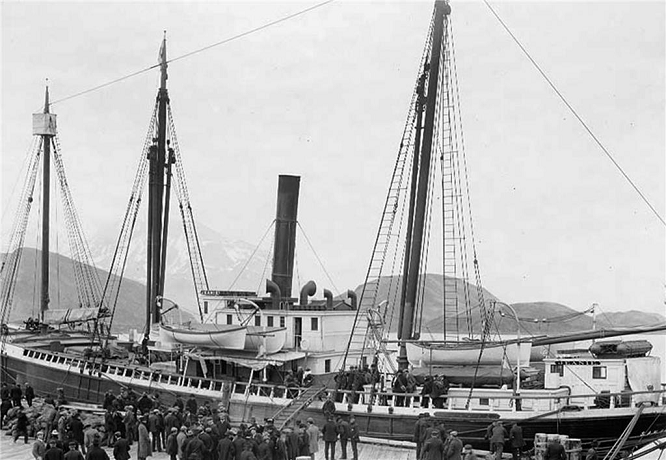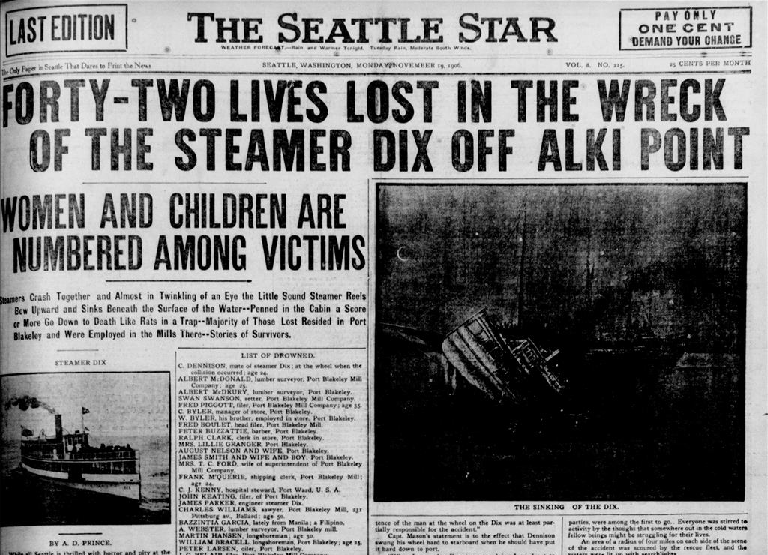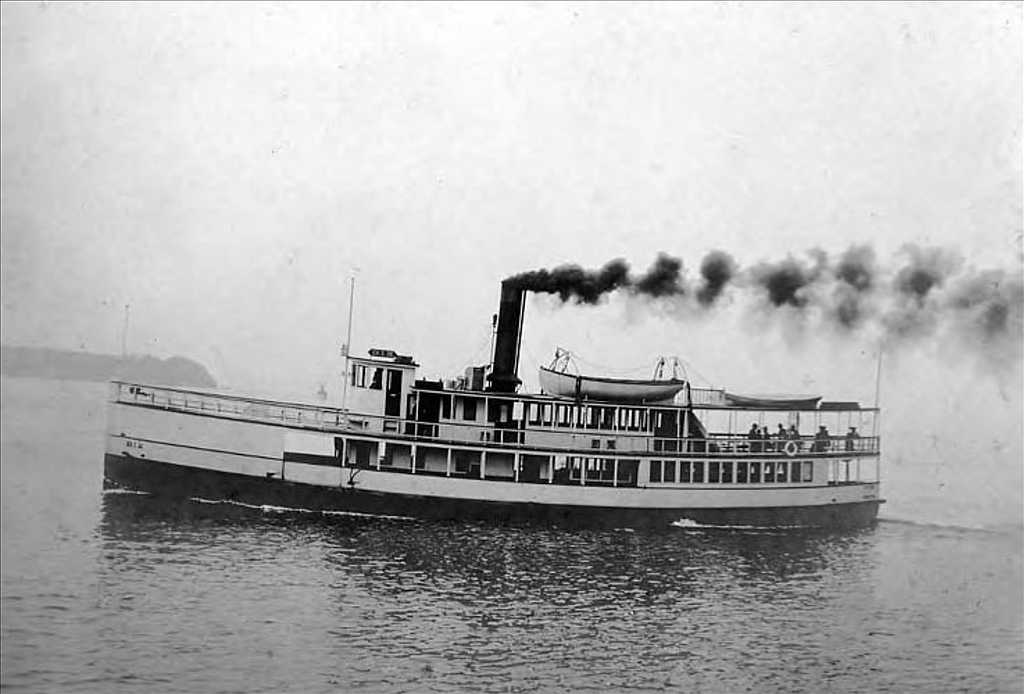117-Year-Old Shipwreck Found in Puget Sound
November 29, 2023 at 11:35 a.m.
“Now, underwater explorers say they’ve located the Dix’s final resting place... The ship sits upright at the bottom of Elliott Bay near Seattle’s Alki Point, submerged under roughly 600 feet of water,” writes the author of the article, Sarah Kuta.
Two men, Matt McCauley and Jeff Hummel, say they’ve known the location of the Dix since 2015 but kept it a secret until now. Both are associated with the Northwest Shipwreck Alliance and say they plan to work with the Washington state legislature to help preserve and protect the Dix.
Between the 1880s and 1920s, hundreds of steamships known as the Mosquito Fleet were the main means of transportation on Puget Sound, and connected otherwise isolated communities, bringing passengers and goods. These boats were mostly reliable, but described as sometimes less seaworthy than they should be. “Unpredictable and dangerous, the ferry system battled weather, water conditions and boiler accidents to connect communities,” according to the Puget Sound Maritime Historical Society.
Here is HistoryLink’s article about the wreck of the S.S. Dix by Daryl C. McClary:
On Sunday, November 18, 1906, the inland passenger steamer SS Dix collides with the steam schooner SS Jeanie two miles north of Alki Point and one mile west of Duwamish Head. The Dix, traveling from downtown Seattle to Port Blakely on Bainbridge Island with 77 passengers and crew on board, sinks within five minutes with a loss of at least 39 lives. It is the greatest maritime disaster ever recorded on Puget Sound.
 On the fateful day, the S.S. Dix rammed the Steamer Jeanie. This photo of the Jeanie, ca. 1899, is by Eric A. Hegg, UW Special Collections (693B)
On the fateful day, the S.S. Dix rammed the Steamer Jeanie. This photo of the Jeanie, ca. 1899, is by Eric A. Hegg, UW Special Collections (693B)
The Ferry to Port Blakely
The SS Dix, one of Puget Sound’s busy “Mosquito Fleet,” was a 130-ton, 102.5-foot inland passenger-steamer built in 1904 by Crawford and Reid in Tacoma, Washington. The ship, owned by the Seattle and Alki Transportation Company, was licensed to ferry 150 passengers and shuttled between downtown Seattle and Alki Beach during the summer months. Vessel inspectors determined the Dix was top heavy due to her narrow beam, only 20.5 feet, and high superstructure. Before certifying the steamer as a passenger carrier, the inspectors required that 30 tons of ballast be installed in the hull for stability. Even with the modification, the ship rolled excessively in rough weather and was considered hard to handle.
Port Blakely is located near the southern tip of Bainbridge Island. In 1906, it was a thriving community and home to the Port Blakely Mill Company, the largest lumber mill in the Northwest and the biggest producer of soft lumber in the world. The lumber mill often had payrolls of 1,200 workers and cut 400,000 board feet of lumber a day. In November, the Port Blakely Mill Company chartered the Dix for six months as a relief vessel for their inland steamer, the SS Monticello, to ferry passengers between Seattle and Port Blakely. The captain was Percy A. Lermond, a veteran of 13 years on Puget Sound as a pilot and master.
The SS Jeanie was a large 1,071-ton, 186-foot, three-masted steam schooner built in Bath, Maine, in 1883, and had run on nearly every route between San Francisco and the Arctic Ocean. In 1906, the vessel, owned by the Alaska Coast Company, was engaged in hauling passengers and freight between Puget Sound ports and southwest Alaska.
The Fateful Day
At 6:45 p.m. on November 18, 1906, the Jeanie, commanded by Captain Philip H. Mason, departed the Great Northern Docks in Smith Cove (now pier 90-91) in Seattle en route to the smelter in Tacoma with 400 tons of iron ore. After leaving Elliot Bay, the vessel proceeded south at a speed of 7 knots. At 7:00 p.m. the Dix, piloted by Captain Lermond, departed Colman Dock (now pier 52, the Washington State Ferry Terminal) on a routine 40-minute run between downtown Seattle and Port Blakely. The passenger steamer proceeded west at a speed of 10.5 knots. The weather on Puget Sound was clear and the wind calm.
Shortly after leaving Colman Dock (known as “The Flyer Dock”), Captain Lermond turned the helm of the Dix over to First Officer Charles Dennison and proceeded into the ship’s cabins to collect fares. The paths of the Jeanie and the Dix began to converge approximately one mile west of Duwamish Head. The Jeanie, which had the right of way, observed the Dix for at least five minutes and began slowing down to allow the steamship to pass. When the Dix continued on an intersecting course, Captain Mason shouted from the bridge “What in the hell are you trying to do?” (Seattle Post-Intelligencer). The Jeanie blew her whistle three times and reversed her engines in an attempt to avoid a collision.
Dennison apparently neither heard the signal nor saw the Jeanie. At the last minute, he signaled the engine room to reverse engines but it was too late. Inexplicably, instead of steering to port to avoid the collision, Dennison put his wheel hard to starboard, placing the Dix in the Jeanie’s direct path. Although the Jeanie had almost stopped, the Dix’s momentum carried her under the Jeanie’s bow. The Dix was struck on the starboard side, just aft of amidships.
The Sinking of the Dix
 Front page Seattle Star, November 19, 1906 Courtesy Library of Congress
Front page Seattle Star, November 19, 1906 Courtesy Library of Congress
The result should have been a minor collision with little damage to either vessel. However, when the overhanging bowsprit of the large schooner connected with the Dix’s high superstructure, the small steamer was healed far over on her port beam and tons of sea water rushed into her hold and cabins. The water plus 30 tons of extra ballast, proved a lethal combination. Five minutes later, the Dix slipped from under the Jeanie’s bow, righted momentarily and then sunk stern first into 100 fathoms (600 feet) of water. The ship sank so fast, it was impossible to distribute life belts or launch life boats. Captain Lermond, who had been pitched into the water, set the exact time at 7:42 p.m., the moment his pocket watch stopped.
Only the passengers on the upper deck were saved, having been swept into the water. The passengers below were trapped in the main cabin and went down with the ship. However, there was one exception; Alice Simpson, age 13, managed to gain the upper deck and was saved. Although she couldn’t swim, Alice was kept afloat by air trapped under her skirts until rescued.
Several passengers were able to catch hold of the chains hanging below the Jeanie’s bowsprit and clamber to safety. The crew of the Jeanie threw lifelines overboard for swimmers to reach and hauled them to the ship. The Jeanie, now dead in the water, immediately lowered two lifeboats and began picking up survivors. Within 20 minutes, 38 people had been rescued including Captain Lermond and Albert Jackson, a deck hand. But First Officer Dennison and three other crewmen disappeared with the ship. The Jeanie searched for more than two hours for more survivors or bodies, but found none. She then returned to the Virginia Street Pier in Seattle to alert authorities of the wreck.
A Stunned Community
When word of a shipwreck involving the Dix reached Port Blakely, the community was stunned. The Port Blakely Mill Company immediately sent the inland steamer Florence K to Seattle to bring home the survivors. When the Florence K arrived at Port Blakely at about 2 a.m., Monday morning, the whole town was waiting at the dock to see who was on board.
The next few days were very emotional as people who had been reported missing, turned up alive. The mill shut down all operations and schools closed so the community could mourn their dead. Ships moored in Blakely Harbor waiting for lumber, flew their flags at half-mast. There was concern for Captain Lermond’s safety as some residents thought that he caused the tragedy.
A Watery Grave
Learning of the shipwreck, the Pacific Coast Tugboat Company immediately dispatched two tugboats, the Tyee and the Bahada, to continue searching Puget Sound for survivors and bodies. Except for a cork fender, a life raft, and one damaged life belt, no wreckage from the Dix was ever found. There was a report that a body had been discovered on Alki Beach but it proved unfounded. None of the shipwreck victims were recovered.
When it was revealed that insurance companies could not pay off policies with out proof of death, consideration was given to raising the Dix. However the water was too deep for salvage divers. The Port Blakely citizens petitioned the government to use explosives to liberate the bodies from the wrecked vessel. The Navy advised that it was not within their jurisdiction to depth-charge Puget Sound and referred the petitioners to the Army Corps of Engineers. Major Hiram M. Chittenden decided against using explosives in favor of dragging the sound’s bottom with grappling hooks. Drag operations over a period of months failed to locate the wreck and were eventually suspended.
The Investigation
On November 21, 1906, Captains Bion B. Whitney and Robert A. Turner, U. S. Marine Inspection Service, commenced an investigation into the Dix disaster. Since the Jeanie was largely undamaged and the Dix was sitting on the bottom of Puget Sound, the inspectors relied on witness testimony to reconstruct the accident.
The official report, dated December 15, 1906, exonerated Captain Philip H. Mason, master of the Jeanie, from all responsibility for the collision. The blame was placed on First Officer Charles Dennison for failure to observe the right-of-way. In addition, the investigation discovered that while Dennison was licensed as a First Officer, he did not have a license to pilot the inland waters of Puget Sound and therefore should not have been at the helm of the Dix. The inspectors also strongly condemned steamship companies for the practice of requiring captains to leave the bridge to act as pursers collecting fares.
Captain Percy Lermond, held legally responsible for the safe navigation of the Dix, had his license as “a master and pilot of Puget Sound and tributaries from Olympia to Cape Flattery” revoked. The inspectors held that Captain Lermond violated maritime law by negligently failing to provide an efficient lookout and by relinquishing command of the vessel to an officer not duly qualified by law. His license was reinstated a year later, but he was never again the master of an inland passenger vessel. Instead, he became a tugboat captain, working on Puget Sound until the 1930s.
In April 1907, Port Blakely suffered another disaster when the Port Blakely Mill burned to the ground. The mill was rebuilt and continued operating through World War I (1917-1919) then production was slowly reduced, the result of a post-war Depression. It marked the decline of Port Blakely’s glory days as an industrial center. The mill, owned by Skinner & Eddy in Seattle, eventually closed in 1922 and the population dwindled to fewer than 200 people.
The SS Jeanie met her end on December 19, 1913, while en route from Seattle to southwestern Alaska. She ran aground in heavy fog on Calvert Island in Queen Charlotte Sound, British Columbia, and became a total loss. Fortunately, there were no lives lost. The crew was rescued by the Canadian steamship SS Estevan.
Historians differ on the number of victims of this tragedy, from 39 to 45. The steamship company reported the number of passengers and crew onboard the SS Dix totaled 77. The official tally was 38 survivors and 39 passengers missing. A variable is the number of passengers who may have been on board without paying the fare to the purser. Also, some believed there were 77 passengers and mistakenly added six crew members to the count, boosting the number of victims to 45.
Here is a link to the HistoryLink article, which features photos, newspaper clippings and even a poem about the wreck of the Dix: The SS Dix collides and sinks off Alki Point, with a loss of 39 lives, on November 18, 1906. - HistoryLink.org
- Read the full Smithsonian Magazine article at this link: 117-Year-Old Shipwreck Found in Puget Sound | Smart News| Smithsonian Magazine
HistoryLink Sources:
R. H. Calkins, “The Steamer Dix Tragedy” in High Tide (Seattle: Marine Digest Publishing Co., 1952); Jim Faber, “The Dix” in Steamer’s Wake (Seattle: Enetai Press, 1985); The H. W. McCurdy Maritime History of the Pacific Northwest ed. by Gordon R. Newell (Seattle: Superior Publishing Co., 1966); Gordon R. Newell, Ships of the Inland Sea (Portland, Oregon: Binfords and Mort, 1951); Andrew Price, Jr., Port Blakely: The Community Captain Renton Built (Seattle: Port Blakely Books, Publishers, 1989); “Dix Sinks in Collision; Forty Two Lost,” The Seattle Times, November 19, 1906, p. 1; “Sea Gives Up Evidence of Tragedy,” Ibid., November 19, 1906, p. 2; “Jeanie’s Captain Blames Dix’s Helmsman,” Ibid., November 19, 1906, p. 2; “Disaster to be Investigated,” Ibid., November 19, 1906, p. 2; “Wreck May Never be Recovered,” Ibid., November 19, 1906, p. 3; “Jeanie A Well Known Coasting Steamer,” Ibid., November 19, 1906, p. 4; “May Try to Raise Sunken Death Trap,” Ibid., November 19, 1906, p. 7; “Port Blakely Stricken With Grief,” Ibid., November 19, 1906, p. 8; “Mate in Blamed for Sinking of Dix,” Ibid., November 19, 1906, p. 8; “Dix Death List is Growing Larger,” Ibid., November 20, 1906, p. 1; “Dennison Solely to Blame for Wreck,” Ibid., November 21, 1906, p. 14; “ Captain Usually Leaves Pilot House,” Ibid., November 23, 1906, p. 2; “Submarine Mines Necessary to Raise Dead,” Ibid., November 23, 1906, p. 2; “Captain of Dix Blamed for Disaster,” Ibid., December 16, 1906, p. 1; “Place Blame on Inspectors,” Ibid., December 18, 1906, p. 14; Don Duncan, “Driftwood Diary: Elliott Bay’s Grimmest Ship Disaster,” The Seattle Times Magazine, December 17, 1967, p. 4; C. T. Connover, “Cogitating: When 39 Lives Were Lost in the Sinking of the Dix,” Ibid., April 24, 1948, p. 4; Ross Cunningham, “Tragedy Off Alki Point,” Ibid., May 31, 1976, p. A-13; “Appalling Loss of Life in Wreck Off Alki Point,” Seattle Post-Intelligencer, November 19, 1906, p. 1; “Masters Make Statements,” Ibid., November 19, 1906, p. 4; “Forty Nine May Have Gone Down on Steamer Dix,” Ibid., November 20, 1906, p. 1; “Finds Life Rafts and Preservers,” Ibid., November 20, 1906, p. 2; “Boats Find No Trace of Wreck,” Ibid., November 20, 1906, p. 12; “Exonerate Mason; Blame Lermond,” Ibid., December 16, 1906, p. 1. “Port Blakely” (www.ghosttowns.com/states/wa/portblakely.html); “Port Blakely Companies: History” (www.portblakely.com/companies_history_timeline.html).





